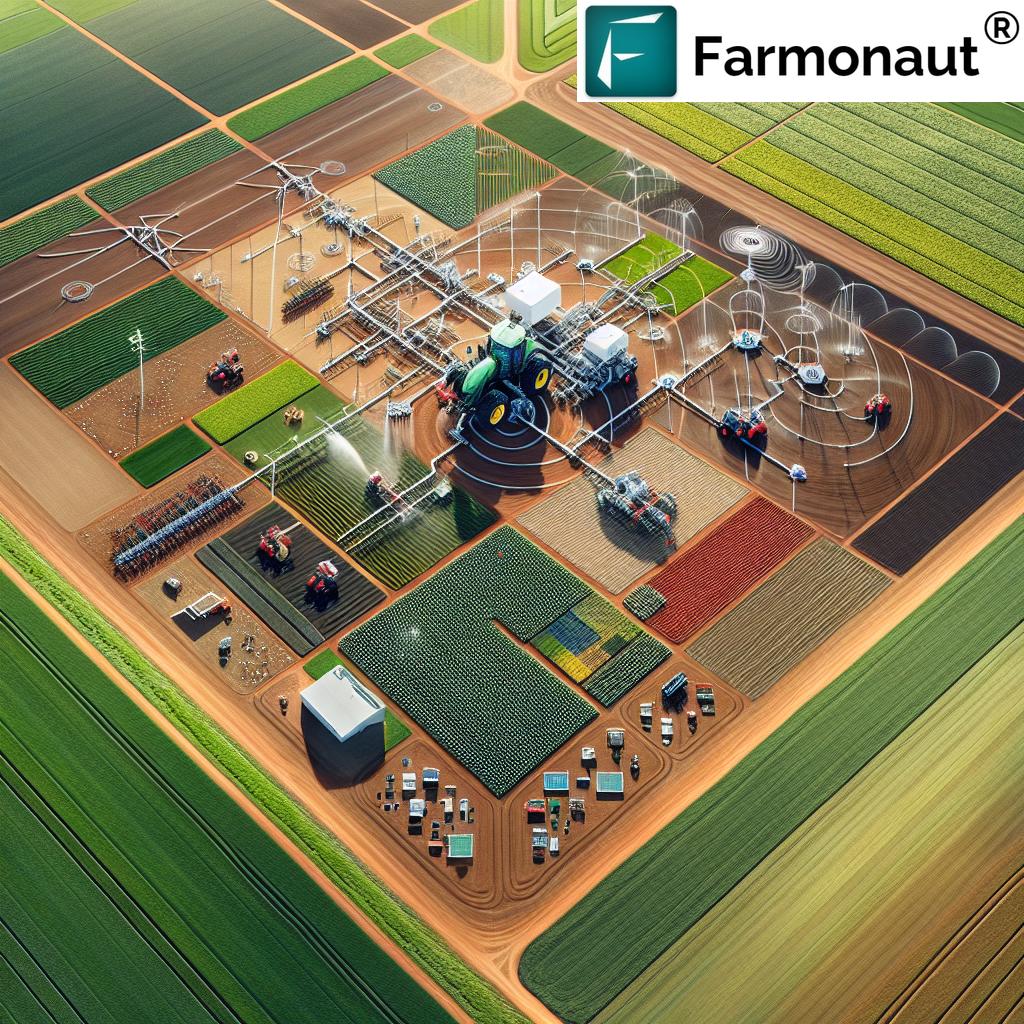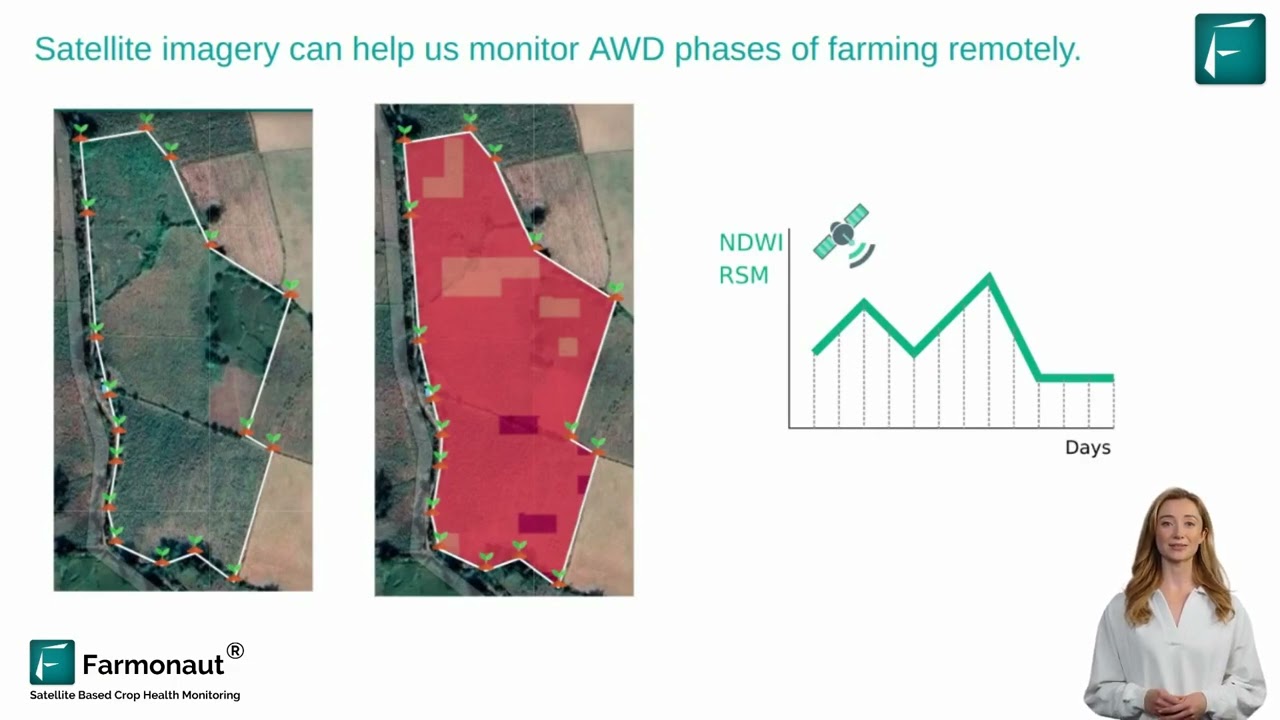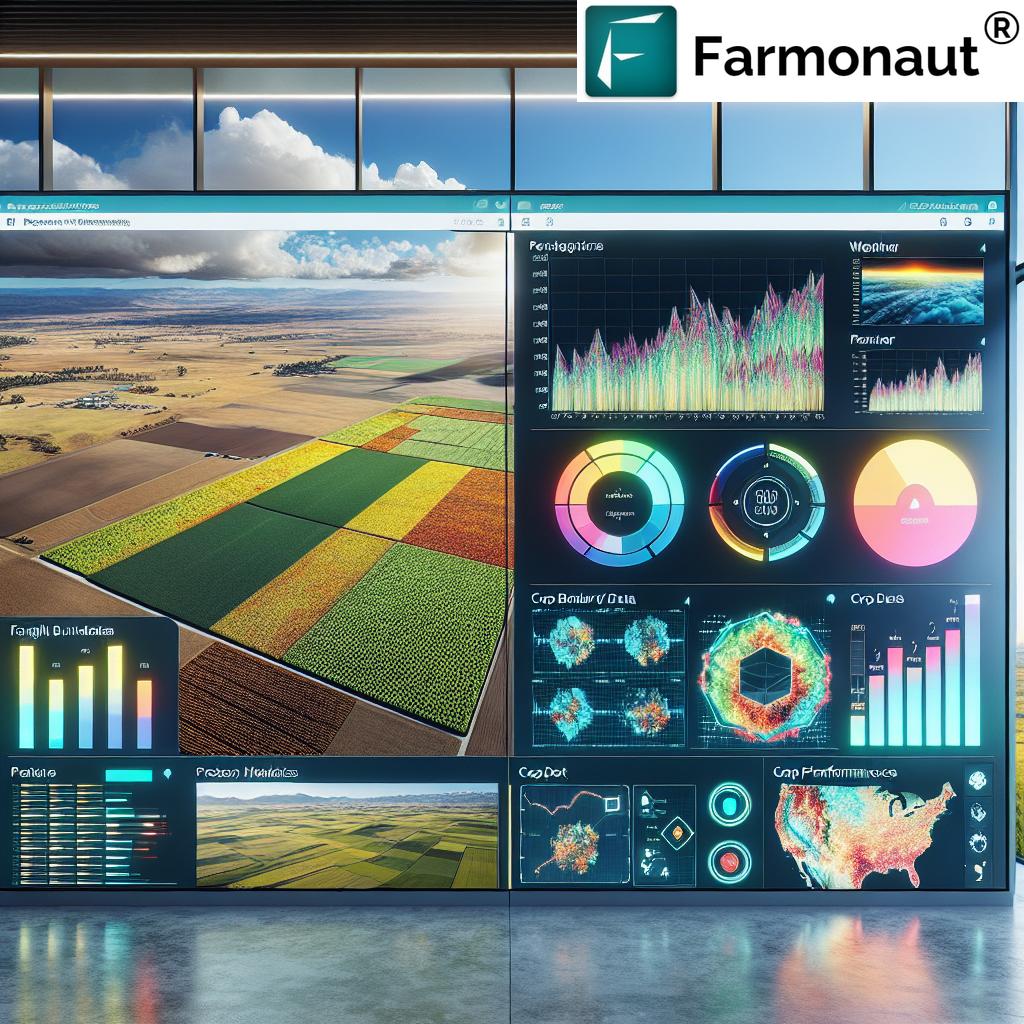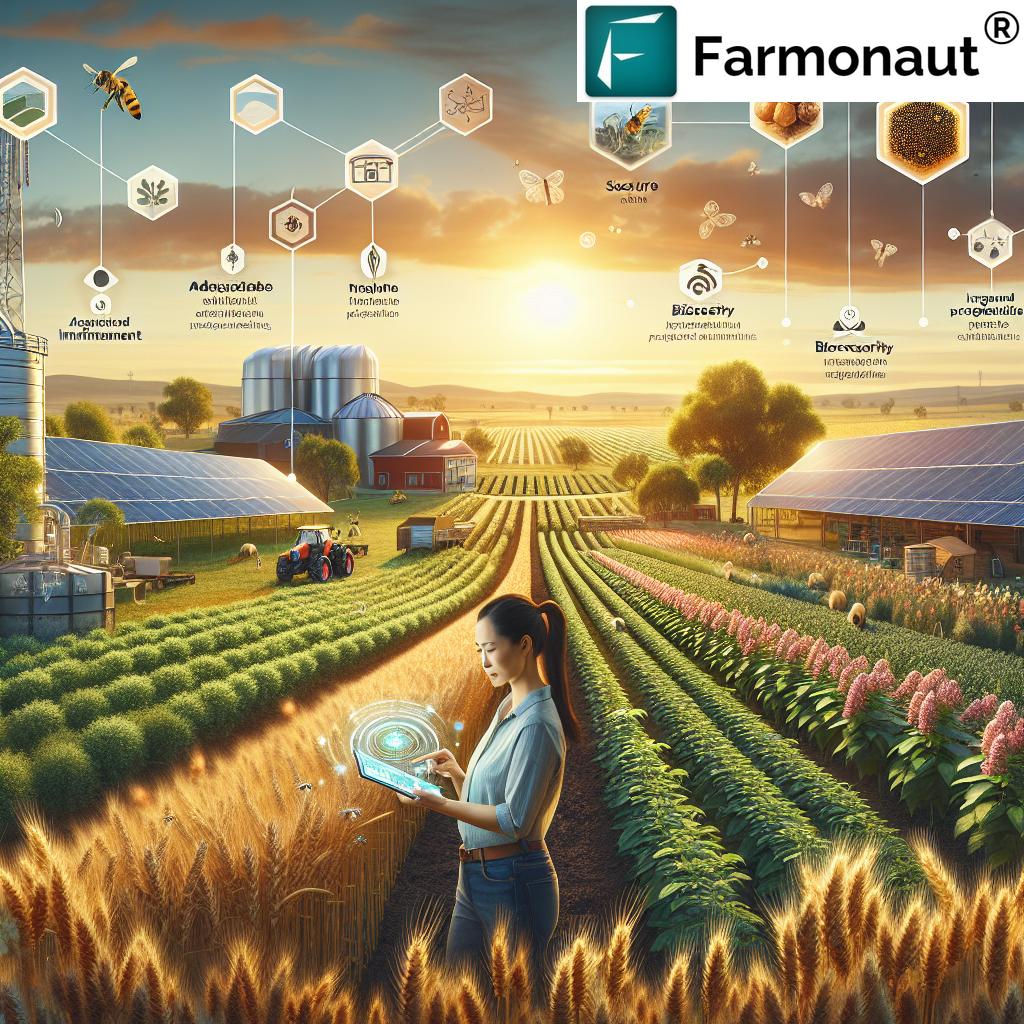Revolutionizing Australian Agriculture: Wireless Water Monitoring for Sustainable Farming Efficiency
“Australian farmers using wireless water monitoring can reduce water usage by up to 30% while maintaining crop yields.”
Welcome to Farmonaut’s latest blog post, where we dive deep into the world of wireless water monitoring and its transformative impact on Australian agriculture. As pioneers in agricultural technology, we are excited to explore how smart irrigation systems and digital agriculture solutions are reshaping the landscape of agribusiness efficiency and sustainability.
In this comprehensive guide, we’ll examine how farmers facing climate challenges can leverage agtech innovations for improved resource management and increased productivity. We’ll highlight the crucial role of wireless farm sensors in providing real-time data on soil moisture and water usage, enabling informed decision-making for optimal crop yields.

The Evolution of Australian Agriculture
Australian agriculture has long been a cornerstone of the nation’s economy, adapting and evolving through challenging climates and vast landscapes. Today, we stand at the cusp of a new agricultural revolution, driven by precision agriculture technology and sustainable farming practices.
- Traditional farming methods are being enhanced by digital solutions
- Agtech innovations are addressing water scarcity and climate variability
- Wireless water monitoring is emerging as a game-changer for farm resource management
As we delve into the world of wireless water monitoring, it’s crucial to understand its significance in the context of Australian farming. With water being a precious resource, especially in our arid and semi-arid regions, efficient water management is not just beneficial – it’s essential for the future of agriculture.
Understanding Wireless Water Monitoring
Wireless water monitoring systems are at the forefront of agtech innovations, revolutionizing how we approach irrigation and water management in agriculture. These systems utilize a network of sensors and transmitters to collect and relay real-time data on various water-related parameters.
- Soil moisture sensors measure water content at different soil depths
- Weather stations collect data on rainfall, temperature, and evaporation rates
- Flow meters track water usage in irrigation systems
- Data is transmitted wirelessly to central management platforms
By implementing wireless water monitoring, farmers gain unprecedented insights into their water resources, allowing for more precise and efficient irrigation practices.
The Impact of Smart Irrigation Systems
Smart irrigation systems, powered by wireless water monitoring technology, are transforming water management in Australian agriculture. These systems integrate real-time data with automated control mechanisms to optimize water usage and crop health.
- Precision water application based on crop needs and soil conditions
- Automated scheduling adjusts to weather forecasts and soil moisture levels
- Remote monitoring and control via smartphone apps or web interfaces
- Integration with other farm management software for comprehensive oversight
The adoption of smart irrigation systems leads to significant improvements in water use efficiency, crop yields, and overall farm productivity.
Experience the power of smart irrigation with Farmonaut’s app

Wireless Farm Sensors: The Eyes and Ears of Modern Agriculture
Wireless farm sensors are the backbone of precision agriculture technology, providing farmers with a wealth of data to inform their decision-making processes. These sensors can monitor a wide range of parameters crucial for optimal crop growth and resource management.
- Soil moisture sensors at various depths for precise irrigation timing
- Temperature sensors to monitor frost risk and heat stress
- Humidity sensors for disease prevention and irrigation planning
- Nutrient sensors to guide fertilization strategies
By leveraging data from these sensors, farmers can make informed decisions about irrigation, fertilization, and crop protection, leading to improved yields and reduced input costs.

The Role of Digital Agriculture Solutions
Digital agriculture solutions encompass a wide range of technologies and platforms designed to enhance farm management and decision-making. These solutions integrate data from various sources, including wireless water monitoring systems, to provide comprehensive insights and recommendations.
- Farm management software for planning and record-keeping
- Crop modeling tools to predict yields and optimize inputs
- Remote sensing technologies for large-scale crop monitoring
- Data analytics platforms for actionable insights
By adopting digital agriculture solutions, Australian farmers can streamline their operations, reduce risks, and make data-driven decisions to improve overall farm performance.
“Smart irrigation systems can increase agricultural productivity by 20-25% compared to traditional farming methods.”
Enhancing Agribusiness Efficiency through Technology
The integration of wireless water monitoring and other precision agriculture technologies is driving significant improvements in agribusiness efficiency. By optimizing resource use and streamlining operations, Australian farmers can achieve better outcomes with fewer inputs.
- Reduced water waste through precise irrigation
- Lower energy costs for pumping and distribution
- Decreased labor requirements for monitoring and management
- Improved crop quality and consistency
- Enhanced ability to meet regulatory requirements and sustainability goals
These efficiency gains translate directly to improved profitability and competitiveness for Australian agribusinesses.
Explore Farmonaut’s API for advanced agribusiness solutions
Promoting Sustainable Farming Practices
Sustainability is a key focus for modern agriculture, and wireless water monitoring plays a crucial role in promoting environmentally friendly farming practices. By optimizing water use and reducing waste, these technologies help conserve precious resources and minimize environmental impact.
- Reduced water extraction from natural sources
- Minimized runoff and nutrient leaching
- Lower carbon footprint through efficient resource use
- Improved soil health through optimal moisture management
Adopting sustainable farming practices not only benefits the environment but also enhances the long-term viability and resilience of Australian agriculture.
Overcoming Climate Challenges with Agtech Innovations
Australian farmers face numerous climate-related challenges, including drought, heatwaves, and unpredictable rainfall patterns. Agtech innovations, particularly in the realm of wireless water monitoring, are providing powerful tools to mitigate these risks and adapt to changing conditions.
- Drought resilience through improved water use efficiency
- Better management of frost and heat stress events
- Adaptive irrigation strategies based on real-time weather data
- Enhanced decision-making for crop selection and planting timing
By leveraging these technologies, farmers can build more resilient and adaptive agricultural systems capable of thriving in the face of climate variability.
Access Farmonaut’s API Developer Docs for climate-smart solutions
The Economic Impact of Wireless Water Monitoring
The adoption of wireless water monitoring and related precision agriculture technologies has significant economic implications for Australian agriculture. By improving efficiency and productivity, these innovations are driving growth and competitiveness in the sector.
- Increased crop yields and quality leading to higher revenues
- Reduced input costs for water, energy, and labor
- Improved risk management and financial stability
- Enhanced market access through sustainable production practices
- New job opportunities in agtech and related fields
As more farms embrace these technologies, we expect to see continued growth and innovation in the Australian agricultural sector.
Integrating Wireless Water Monitoring with Other Agricultural Technologies
Wireless water monitoring systems don’t operate in isolation. They are part of a broader ecosystem of agricultural technologies that work together to optimize farm operations. Integration with other innovative tools can further enhance the benefits of wireless water monitoring.
- Precision seeding equipment for optimal plant spacing and water use
- Variable-rate fertilizer application based on soil moisture data
- Drone and satellite imagery for large-scale crop health assessment
- Biostimulants to enhance crop resilience and water use efficiency
- Advanced harvest management tools for timing and quality control
By adopting a holistic approach to agtech implementation, farmers can create highly efficient and productive agricultural systems.
Download Farmonaut’s mobile apps for on-the-go farm management:


The Future of Wireless Water Monitoring in Australian Agriculture
As we look to the future, the potential for wireless water monitoring and related technologies in Australian agriculture is immense. Ongoing research and development are likely to bring even more sophisticated and powerful tools to farmers.
- Advanced AI and machine learning for predictive irrigation
- Internet of Things (IoT) integration for seamless farm-wide connectivity
- Blockchain technology for water rights management and traceability
- Nanotechnology sensors for ultra-precise soil and plant monitoring
- Robotics and automation for water management tasks
These emerging technologies promise to further revolutionize water management in agriculture, driving even greater efficiency and sustainability.
Comparison: Traditional vs. Wireless Water Monitoring in Australian Agriculture
| Aspect | Traditional Methods | Wireless Monitoring Systems |
|---|---|---|
| Real-time Data Collection | Manual, infrequent | Continuous, automated |
| Water Usage Efficiency | 60-70% efficiency | 85-95% efficiency |
| Labor Requirements | High – regular field checks | Low – remote monitoring |
| Cost-effectiveness | Higher long-term costs | Initial investment, lower long-term costs |
| Environmental Impact | Higher water waste, potential over-irrigation | Reduced water waste, optimal irrigation |
Implementing Wireless Water Monitoring: Best Practices for Australian Farmers
For Australian farmers looking to adopt wireless water monitoring systems, following best practices can help ensure successful implementation and maximize benefits:
- Conduct a thorough farm assessment: Understand your specific water management needs and challenges.
- Choose the right system: Select a wireless monitoring solution that fits your farm size, crop types, and budget.
- Proper sensor placement: Strategically position sensors to capture representative data across your fields.
- Integration with existing systems: Ensure compatibility with your current irrigation and farm management tools.
- Staff training: Invest in training for your team to effectively use and maintain the new technology.
- Regular calibration and maintenance: Keep your system accurate and reliable through regular checks and updates.
- Data analysis and application: Develop strategies to effectively use the data for decision-making.
- Continuous improvement: Regularly review and refine your water management practices based on collected data.
By following these best practices, farmers can maximize the benefits of wireless water monitoring and drive significant improvements in their operations.
Overcoming Barriers to Adoption
While the benefits of wireless water monitoring are clear, some barriers to adoption still exist for Australian farmers. Addressing these challenges is crucial for widespread implementation of this technology:
- Initial cost of implementation
- Technical knowledge and skills required
- Reliability of internet connectivity in remote areas
- Integration with legacy irrigation systems
- Data privacy and security concerns
Industry stakeholders, including technology providers, government agencies, and agricultural organizations, are working together to overcome these barriers and facilitate broader adoption of wireless water monitoring systems.
The Role of Policy in Promoting Agtech Adoption
Government policies play a crucial role in encouraging the adoption of wireless water monitoring and other agtech innovations in Australian agriculture. Supportive policies can help accelerate the transition to more efficient and sustainable farming practices:
- Financial incentives for technology adoption
- Research and development funding for agtech innovations
- Education and training programs for farmers
- Infrastructure improvements to support digital agriculture
- Regulatory frameworks that encourage sustainable water use
By creating an enabling environment for agtech adoption, policymakers can help drive the transformation of Australian agriculture towards a more efficient and sustainable future.
Conclusion: Embracing the Future of Australian Agriculture
Wireless water monitoring and related precision agriculture technologies are revolutionizing farming practices in Australia. By providing real-time data and insights, these innovations enable farmers to make informed decisions, optimize resource use, and increase productivity while promoting sustainability.
As we face the challenges of climate change and increasing demand for food production, the adoption of these technologies will be crucial for the future of Australian agriculture. By embracing wireless water monitoring and other agtech solutions, farmers can build more resilient, efficient, and profitable operations that are well-equipped to thrive in the 21st century.
At Farmonaut, we are committed to driving this agricultural revolution by providing cutting-edge solutions that empower farmers to make data-driven decisions and optimize their operations. Together, we can build a more sustainable and prosperous future for Australian agriculture.
Farmonaut Subscriptions
Frequently Asked Questions (FAQ)
- What is wireless water monitoring in agriculture?
Wireless water monitoring in agriculture involves using sensors and wireless technology to collect real-time data on soil moisture, weather conditions, and water usage. This information helps farmers make informed decisions about irrigation and water management. - How does wireless water monitoring benefit Australian farmers?
It helps farmers optimize water use, reduce costs, improve crop yields, and promote sustainable farming practices by providing accurate, real-time data for decision-making. - What types of sensors are used in wireless water monitoring systems?
Common sensors include soil moisture sensors, weather stations, flow meters, and temperature sensors. These work together to provide a comprehensive picture of water-related conditions on the farm. - How does wireless water monitoring integrate with other farm management tools?
Wireless water monitoring systems can integrate with farm management software, irrigation controllers, and other precision agriculture technologies to create a comprehensive farm management ecosystem. - What is the cost of implementing a wireless water monitoring system?
Costs vary depending on farm size and system complexity. While there is an initial investment, many farmers find the long-term benefits in water savings and yield improvements outweigh the costs. - How can farmers get started with wireless water monitoring?
Farmers can begin by assessing their specific needs, researching available systems, and potentially starting with a small-scale pilot project before full implementation. - Are there government incentives for adopting wireless water monitoring technology?
Some Australian states and territories offer incentives or grants for adopting water-efficient technologies. Check with local agricultural departments for current programs. - How does wireless water monitoring contribute to sustainable farming?
By optimizing water use, reducing waste, and improving overall farm efficiency, wireless water monitoring helps farmers reduce their environmental impact and promote sustainable agricultural practices.
We hope this comprehensive guide has provided valuable insights into the transformative potential of wireless water monitoring in Australian agriculture. As we continue to innovate and develop new solutions, we look forward to supporting farmers in their journey towards more efficient, sustainable, and profitable farming practices.

















